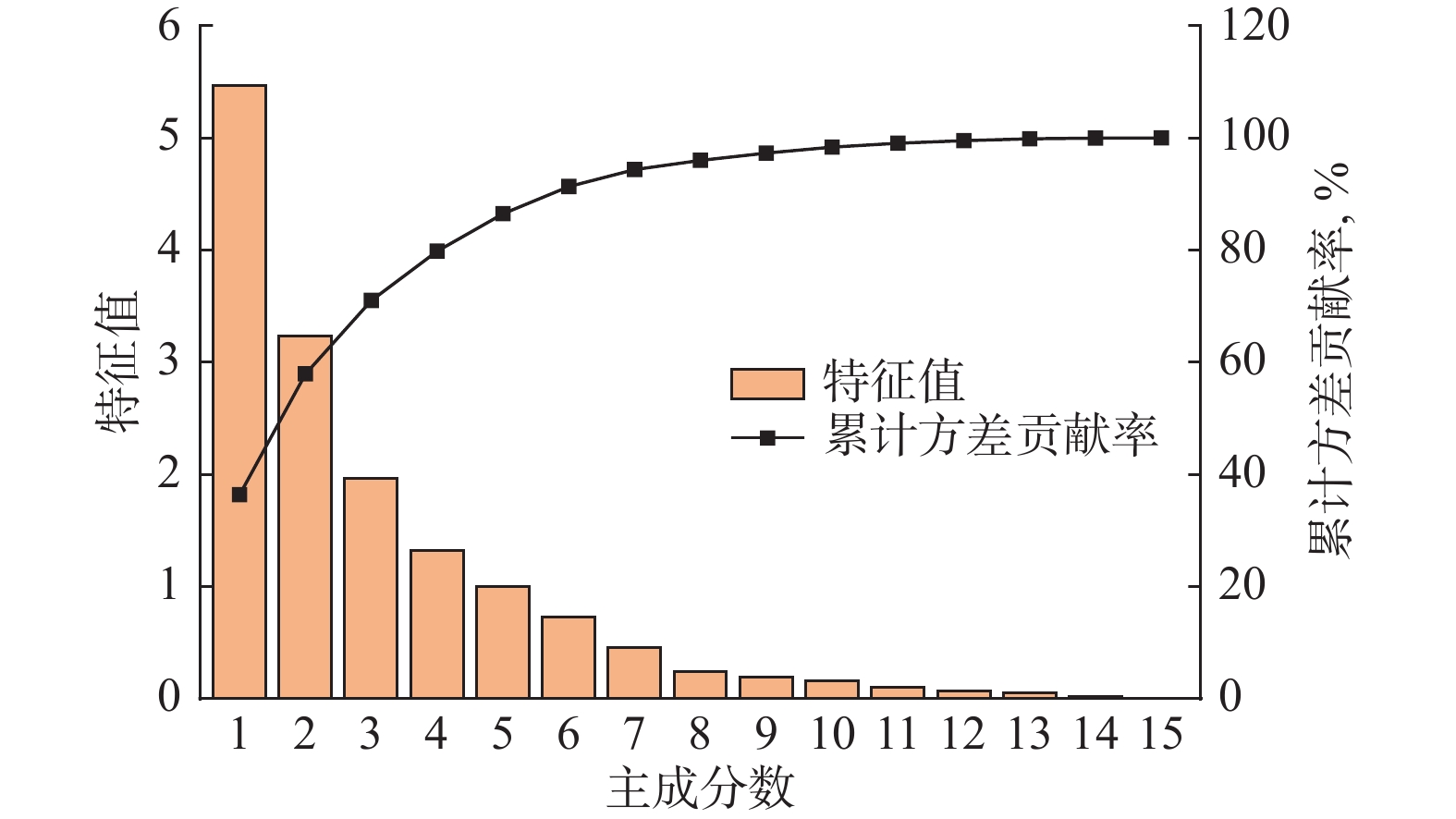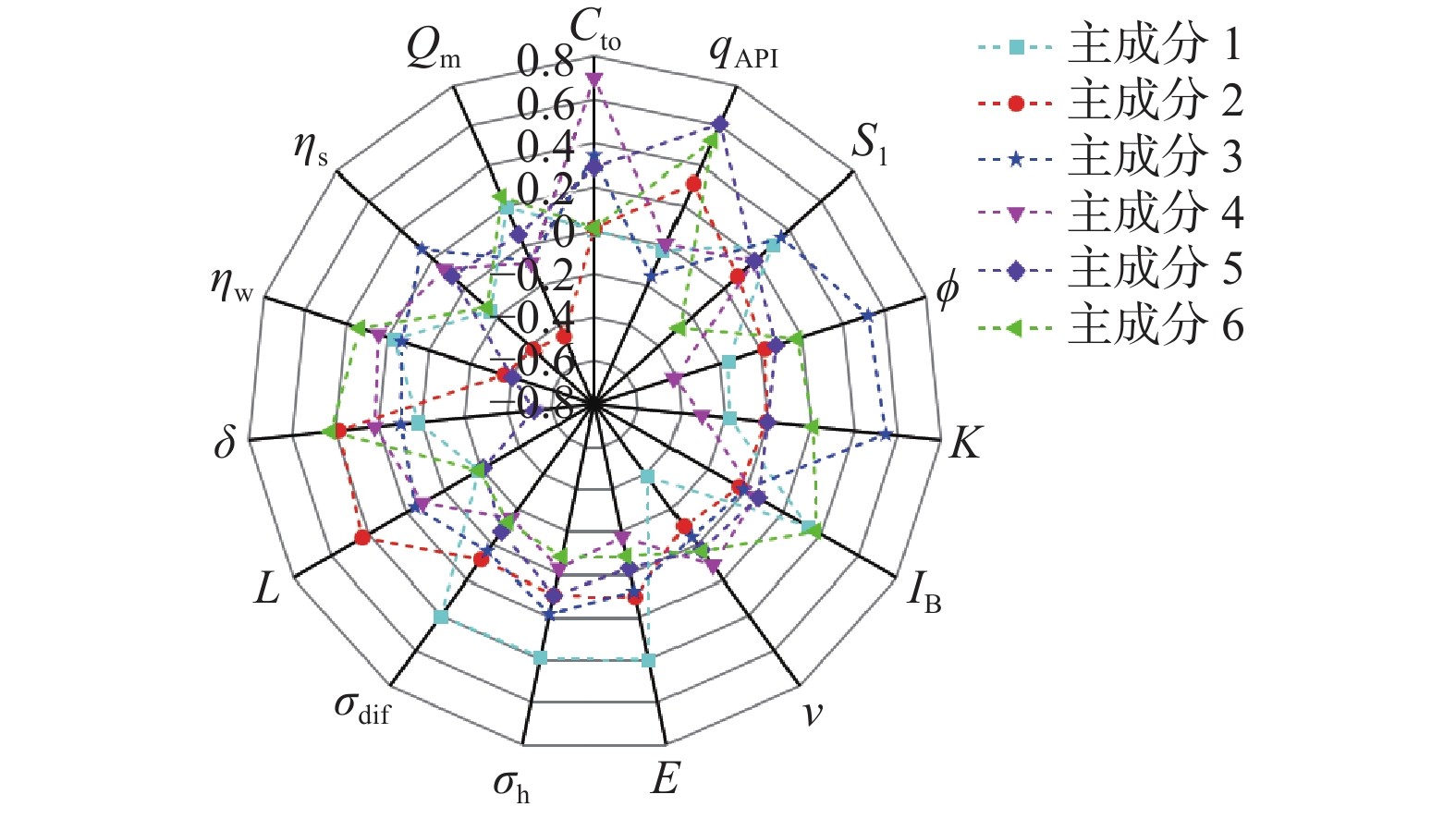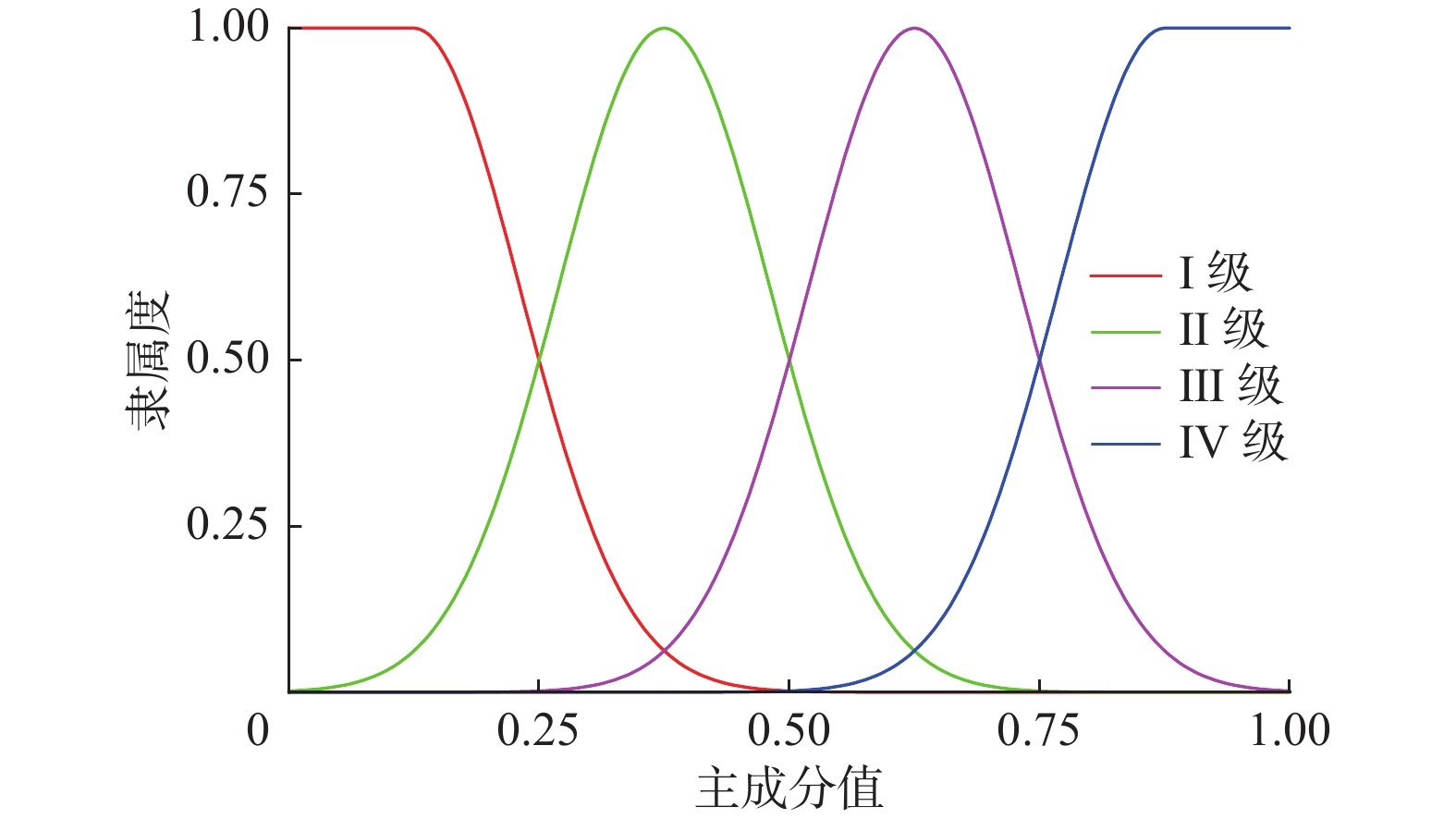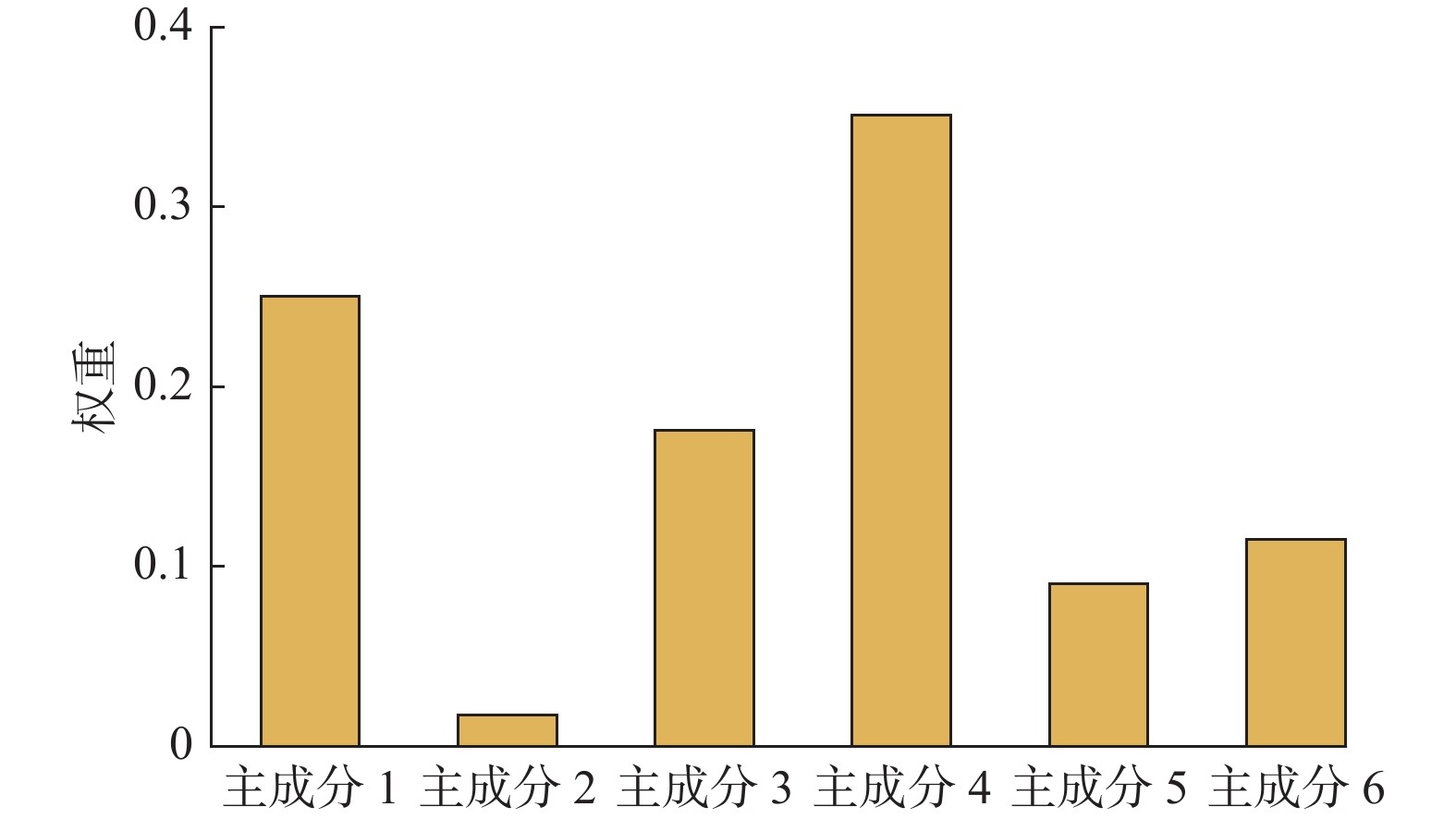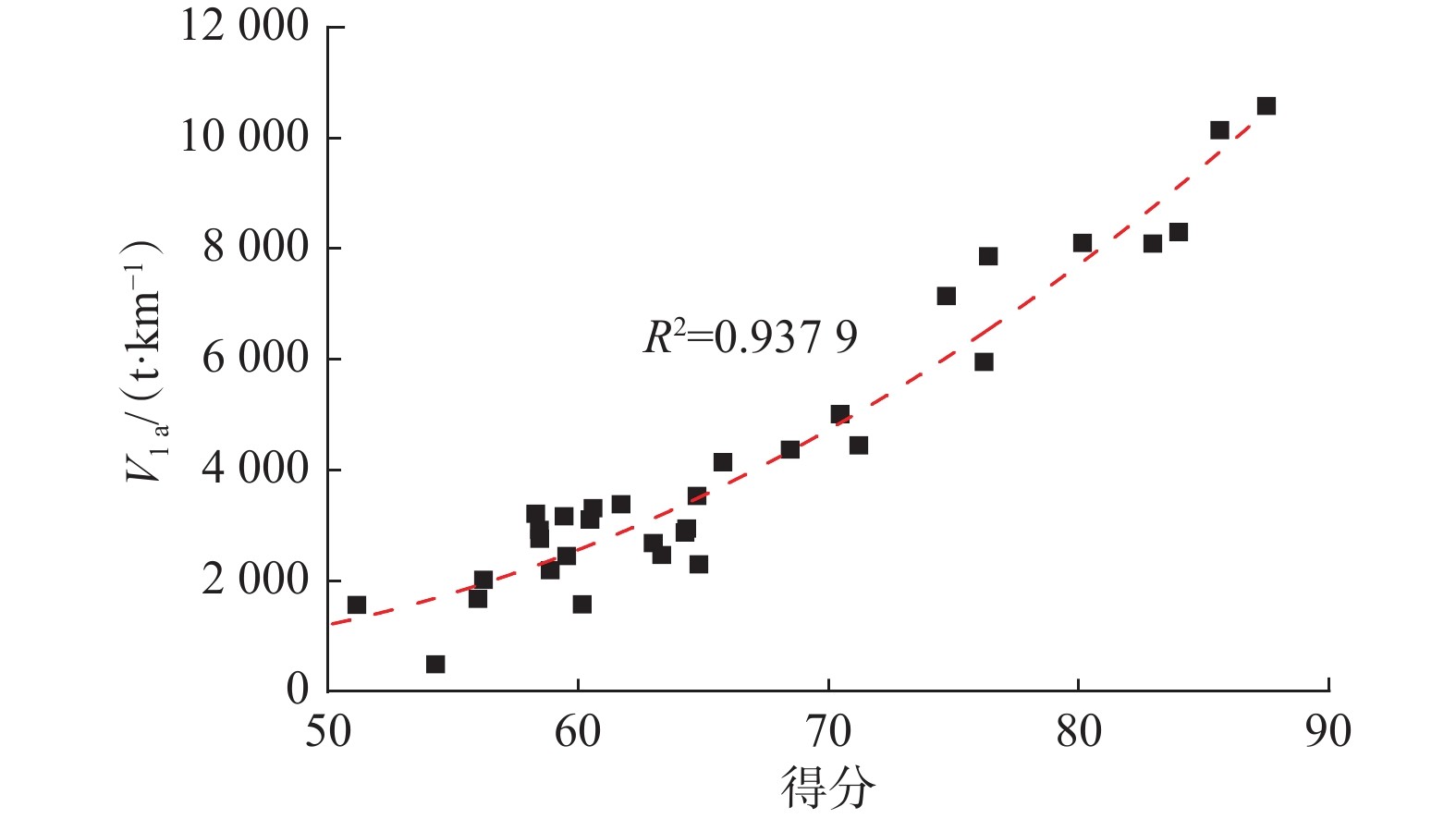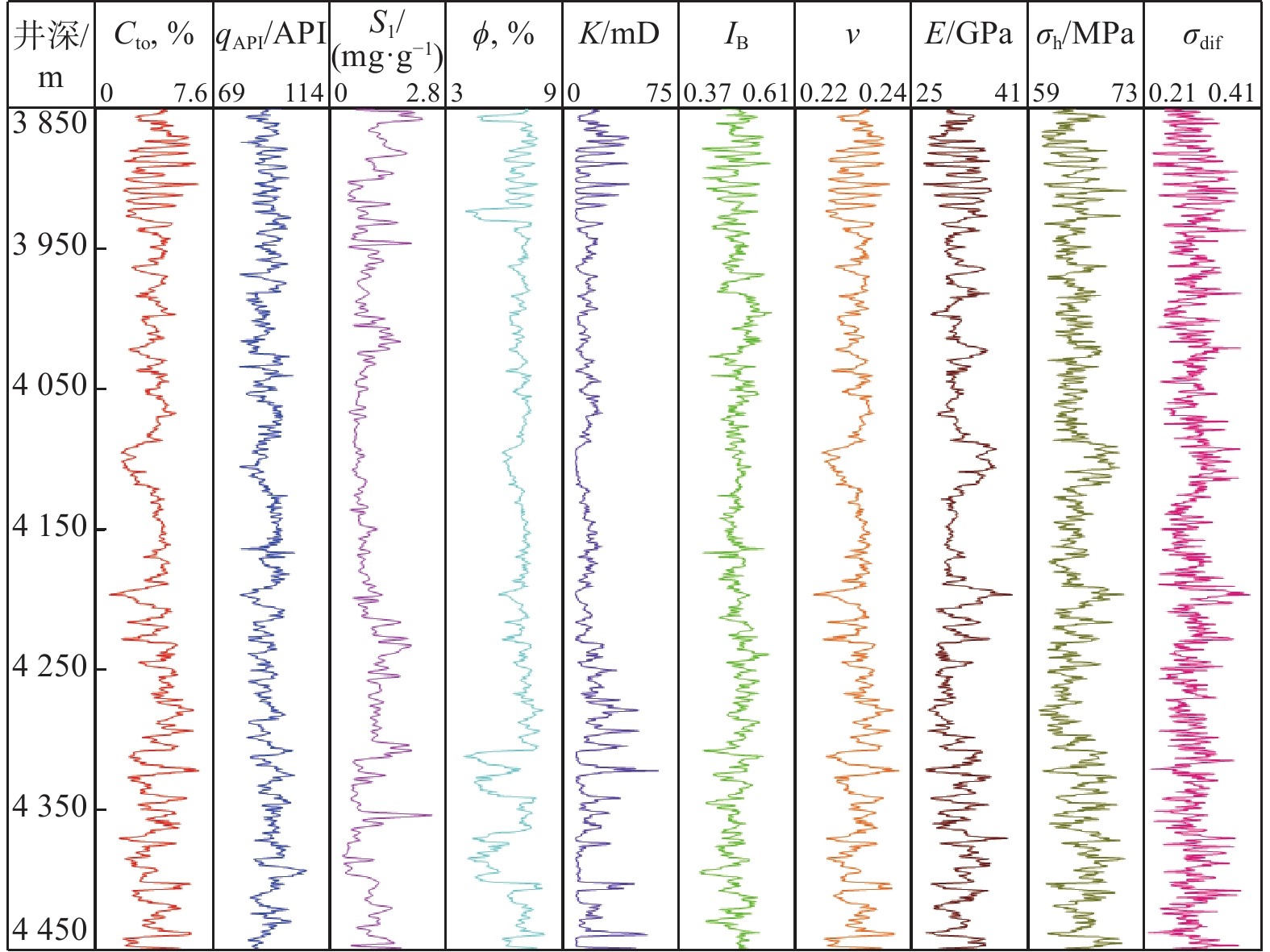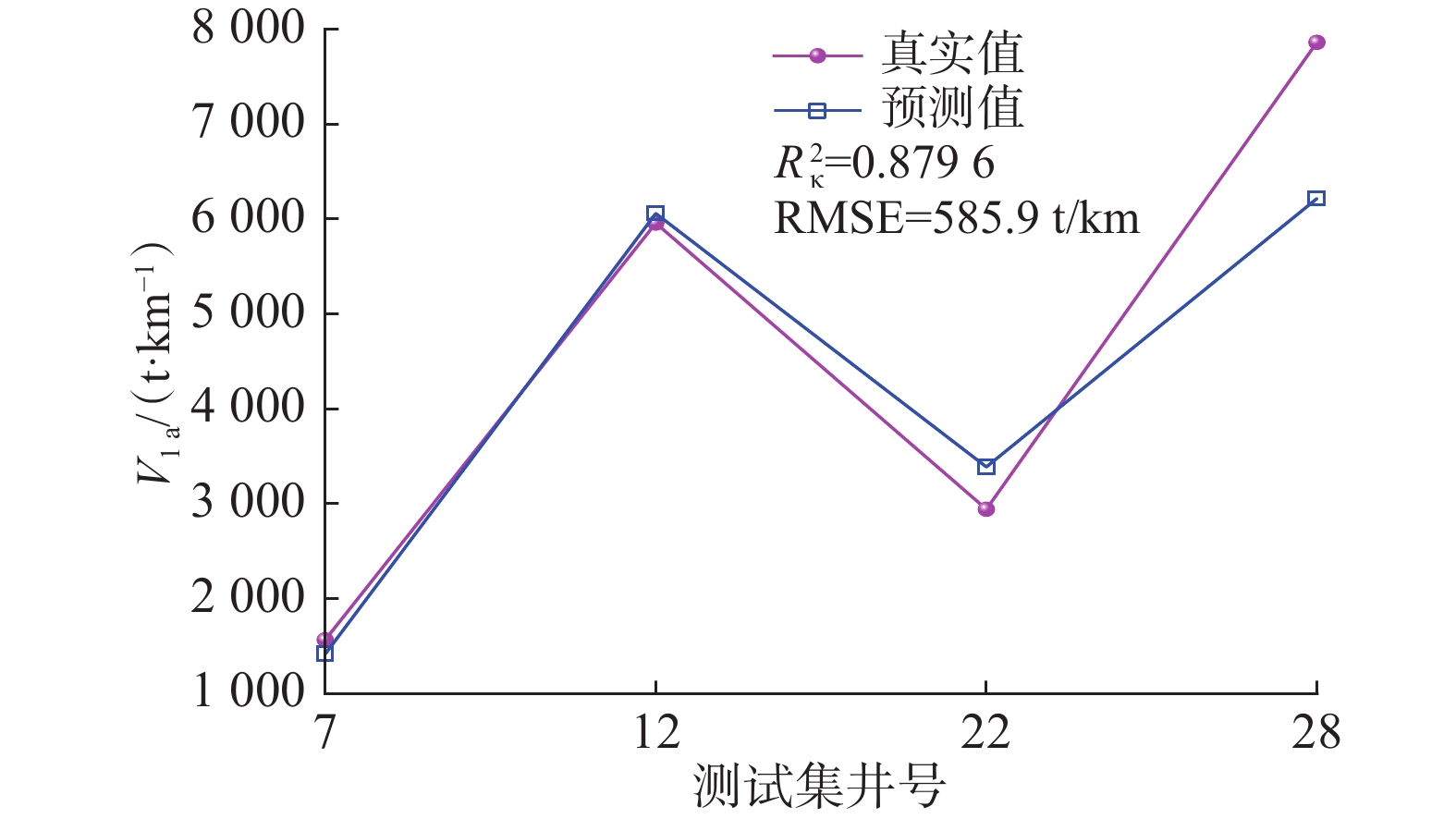Research on Data-Driven Intelligent Optimization of Fracturing Treatment Parameters for Shale Oil Horizontal Wells
-
摘要:
针对目前数智化压裂施工参数设计针对性不足、流程不畅通等问题,建立了基于数据驱动的压裂施工参数智能优化方法。以CD区块32口页岩油井为研究对象,采用主成分分析法处理代表储层地质特征、工程品质和施工参数的15项产量影响因素,使之降低维度,引入高斯隶属函数和熵权法进行储层压裂非均质性模糊综合评价,结合支持向量回归和粒子群优化算法,以产量最高为目标,推荐射孔位置、段长、簇间距、单位长度液量、单位长度砂量和排量。研究结果表明,渗透率、孔隙度、热解游离烃含量、单位长度液量和单位长度砂量为研究区块的产量主控因素。应用实例井采用优化的参数施工后,第一压裂段8簇均成功起裂,裂缝半长59.50~154.80 m,产量预测符合率为94.86%。研究表明,该方法可实现有效储层质量评价、产量预测和匹配储层地质条件施工参数的快速优化,推动页岩油等非常规储层高效开发。
Abstract:A data-driven intelligent optimization method for fracturing treatment parameters was proposed to address the issues of insufficient pertinence and incomplete process design in digital fracturing treatment parameters. With 32 shale oil wells in the CD block as the research object, principal component analysis was used to reduce the 15 production-influencing factor dimensions representing geological attributes, engineering quality, and construction parameters of the reservoir. A Gaussian membership function and entropy weight method were introduced for a fuzzy comprehensive evaluation of reservoir fracturing heterogeneity. Combined with support vector regression and particle swarm optimization algorithms, the perforation location, segment length, cluster spacing, fracturing fluid intensity, sanding intensity, and discharge capacity were recommended with the highest production as the goal. The research results indicated that permeability, porosity, free hydrocarbon content by pyrolysis, fracturing fluid intensity, and sanding intensity were the main control factors for the production of the target block. All eight clusters of the first fracturing section of the application well have successfully initiated fractures during treatment with optimized parameters, with a half-length of 59.50–154.80 m and a production prediction accuracy of 94.86%. The method proposed can achieve effective reservoir quality evaluation, production prediction, and rapid optimization of treatment parameters that match reservoir geological conditions, promoting efficient shale oil development in unconventional reservoirs.
-
-
表 1 样本数据库
Table 1 Sample database
井号 Cto,
%qAPI/
APIS1/
(mg·g−1)ϕ K/
mDIB ν E/
GPaσh/
MPaσdif L/
mδ/
mηw/
(m3·m−1)ηs/
(m3·m−1)Qm/
(m3·min−1·m−1)Np/
(t·km−1)Y1 3.1 93.6 0.5 6.5 6.11 0.51 0.230 30.77 56.7 0.250 48.0 6.9 23.9 2.6 0.25 8 302.9 Y2 1.8 52.5 1.1 5.5 1.24 0.62 0.228 36.61 79.8 0.279 29.8 5.2 47.9 3.2 0.43 2 682.9 Y3 3.5 89.4 0.9 5.6 0.42 0.56 0.231 27.10 89.7 0.286 65.1 7.6 26.7 2.1 0.17 491.6 Y4 4.5 91.1 2.0 7.3 0.96 0.48 0.231 27.20 56.8 0.235 51.7 6.7 36.2 3.5 0.28 2 466.0 Y5 1.9 95.5 0.5 6.4 0.87 0.30 0.230 30.59 82.8 0.271 66.0 7.9 22.7 2.5 0.13 1 575.9 Y6 4.0 91.8 5.0 8.5 5.80 0.52 0.228 35.25 83.3 0.267 59.7 9.0 30.7 2.6 0.20 8 094.0 Y7 2.2 91.6 0.5 5.4 0.56 0.30 0.230 30.59 73.8 0.251 63.5 7.9 20.9 2.4 0.17 1 566.0 Y8 2.2 98.4 3.1 4.9 0.75 0.57 0.228 37.38 83.0 0.28 43.1 6.4 27.0 2.2 0.31 2 920.6 Y9 2.9 99.2 2.0 5.5 1.06 0.62 0.228 37.67 83.9 0.279 43.9 5.9 23.7 2.0 0.28 1 674.0 Y10 1.9 107.6 2.7 5.9 1.89 0.62 0.228 37.67 83.9 0.279 47.8 5.9 21.5 1.6 0.25 3 167.9 Y11 4.0 93.8 1.9 7.6 1.59 0.51 0.230 32.26 74.2 0.255 46.3 6.0 32.3 3.7 0.24 3 212.2 Y12 2.9 112.8 0.7 7.8 3.85 0.41 0.230 30.57 58.6 0.244 36.2 5.9 26.9 2.6 0.32 5 956.8 Y13 3.2 82.2 3.4 9.9 8.73 0.62 0.228 36.61 79.8 0.279 45.9 6.6 35.0 3.2 0.29 10 581.3 Y14 3.7 103.0 4.7 4.5 0.45 0.57 0.227 36.91 88.4 0.275 55.4 7.9 28.9 2.5 0.23 2 873.9 Y15 4.0 85.3 4.4 4.4 0.51 0.42 0.228 37.14 85.2 0.278 56.7 7.4 29.2 2.8 0.22 2 449.7 Y16 3.1 102.2 4.6 7.7 1.87 0.60 0.228 39.67 89.6 0.288 53.4 7.7 31.7 2.9 0.24 4 371.5 Y17 3.8 92.1 4.5 7.5 4.35 0.62 0.228 36.61 79.8 0.279 42.9 6.2 36.8 3.1 0.31 7 145.3 Y18 2.6 110.3 2.3 4.8 0.88 0.62 0.228 37.67 83.9 0.279 41.1 5.6 26.8 2.2 0.30 2 759.9 Y19 3.4 92.6 2.0 5.3 1.16 0.62 0.228 36.61 79.8 0.279 32.7 5.5 41.4 2.8 0.38 2 300.7 Y20 2.2 91.0 0.4 6.5 1.45 0.48 0.228 33.51 68.2 0.259 56.6 7.1 37.4 2.8 0.31 3 533.4 Y21 3.7 110.0 2.7 7.3 2.73 0.57 0.228 37.38 83.0 0.28 63.1 16.5 36.0 2.4 0.20 5 011.7 Y22 3.5 91.1 3.0 5.6 0.68 0.50 0.228 34.37 84.5 0.264 64.0 8.7 27.1 2.6 0.19 2 943.1 Y23 3.6 101.6 3.9 9.1 6.23 0.62 0.228 36.61 79.8 0.249 43.5 6.3 39.2 3.4 0.30 8 105.3 Y24 4.1 84.9 6.1 6.4 0.82 0.60 0.228 39.67 89.6 0.288 56.9 8.4 28.2 2.5 0.22 4 144.5 Y25 4.2 109.0 3.2 4.7 0.48 0.50 0.229 32.78 82.0 0.255 56.9 6.9 30.8 2.7 0.22 3 109.4 Y26 3.7 102.3 1.1 4.8 1.13 0.57 0.229 33.67 70.9 0.264 53.9 7.3 25.4 2.8 0.21 2 018.5 Y27 3.2 68.2 5.4 6.9 1.46 0.60 0.228 39.67 89.6 0.288 35.2 6.9 42.5 3.1 0.38 3 314.0 Y28 2.5 86.0 0.6 8.2 4.21 0.51 0.230 30.99 60.4 0.249 49.3 7.0 36.7 3.6 0.29 7 863.2 Y29 2.7 104.9 2.3 7.0 2.23 0.62 0.228 37.67 83.9 0.279 61.4 15.8 33.1 2.3 0.17 4 449.0 Y30 2.7 89.0 5.0 10.8 9.36 0.54 0.229 36.91 76.8 0.264 53.8 8.0 29.7 3.5 0.20 10 144.7 Y31 3.0 103.7 4.8 5.2 1.25 0.57 0.228 36.48 86.4 0.271 30.4 5.1 42.0 3.3 0.45 3384.3 Y32 2.1 107.9 2.8 5.8 0.97 0.62 0.228 37.67 83.9 0.279 57.7 6.9 20.6 1.5 0.20 2192.4 表 2 不同段施工参数优化与产量预测结果
Table 2 Optimization of treatment parameters and production prediction results for segments
井段/m 平均得分 压裂段长/m 簇间距/m 加砂强度/
(m3·m−1)用液强度/
(m3·m−1)排量/
(m3·min−1)预测产量/
(t·km−1)3 850~3 931 59.2 60 6.50 3.7 31.0 12.5 4 113.5 3 932~4 056 55.1 45 5.80 2.8 26.0 12.5 3 354.3 4 057~4 232 55.8 50 6.30 2.6 28.0 12.0 3 412.9 4 233~4 306 52.9 52 5.80 3.1 29.0 12.5 2 985.9 4 307~4 450 58.4 45 5.30 3.6 34.5 12.5 3 896.4 表 3 第1段射孔位置优化结果
Table 3 Optimization results of perforation position in the first fracturing section
簇号 顶深/m 底深/m 簇间距/m 簇号 顶深/m 底深/m 簇间距/m ① 4 407.50 4 408.00 5.50 ⑤ 4 431.00 4 431.50 5.00 ② 4 413.50 4 414.00 5.50 ⑥ 4 436.50 4 437.00 5.00 ③ 4 419.50 4 420.00 5.20 ⑦ 4 442.00 4 442.50 5.00 ④ 4 425.20 4 425.70 5.30 ⑧ 4 447.50 4 448.00 -
[1] LU Chunhua, JIANG Hanqiao, QU Shiyuan, et al. Hydraulic fracturing design for shale oils based on sweet spot mapping: a case study of the Jimusar Formation in China[J]. Journal of Petroleum Science and Engineering, 2022, 214: 110568. doi: 10.1016/j.petrol.2022.110568
[2] YANG Ruiyue, QIN Xiaozhou, LIU Wei, et al. A physics-constrained data-driven workflow for predicting coalbed methane well production using artificial neural network[J]. SPE Journal, 2022, 27(3): 1531–1552. doi: 10.2118/205903-PA
[3] 张世昆,陈作. 人工智能在压裂技术中的应用现状及前景展望[J]. 石油钻探技术,2023,51(1):69–77. doi: 10.11911/syztjs.2022115 ZHANG Shikun, CHEN Zuo. Status and prospect of artificial intelligence application in fracturing technology[J]. Petroleum Drilling Techniques, 2023, 51(1): 69–77. doi: 10.11911/syztjs.2022115
[4] 盛茂,李根生,田守嶒,等. 人工智能在油气压裂增产中的研究现状与展望[J]. 钻采工艺,2022,45(4):1–8. SHENG Mao, LI Gensheng, TIAN Shouceng, et al. Research status and prospect of artificial intelligence in reservoir fracturing stimulation[J]. Drilling & Production Technology, 2022, 45(4): 1–8.
[5] 李宾元. 模糊决策在压裂酸化中选井选层的应用[J]. 石油钻采工艺,1989,11(2):75–87. doi: 10.13639/j.odpt.1989.02.017 LI Binyuan. Use of fuzzy decision in selection of well and zones for fracturing and acidzing[J]. Oil Drilling & Production Technology, 1989, 11(2): 75–87. doi: 10.13639/j.odpt.1989.02.017
[6] ZOVEIDAVIANPOOR M, GHARIBI A. Applications of type-2 fuzzy logic system: Handling the uncertainty associated with candidate-well selection for hydraulic fracturing[J]. Neural Computing and Applications, 2016, 27(7): 1831–1851. doi: 10.1007/s00521-015-1977-x
[7] DAVARPANAH A, SHIRMOHAMMADI R, MIRSHEKARI B, et al. Analysis of hydraulic fracturing techniques: Hybrid fuzzy approaches[J]. Arabian Journal of Geosciences, 2019, 12(13): 402. doi: 10.1007/s12517-019-4567-x
[8] GOU Bo, WANG Chuan, YU Ting, et al. Fuzzy logic and grey clustering analysis hybrid intelligence model applied to candidate-well selection for hydraulic fracturing in hydrocarbon reservoir[J]. Arabian Journal of Geosciences, 2020, 13(19): 975. doi: 10.1007/s12517-020-05970-y
[9] VERMA A K, SINGH T N. A neuro-fuzzy approach for prediction of longitudinal wave velocity[J]. Neural Computing and Applications, 2013, 22(7): 1685–1693.
[10] RIOS E H, de VASCONCELLOS AZEREDO R B, MOSS A K, et al. Estimating the permeability of rocks by principal component regressions of NMR and MICP data[J]. Petrophysics, 2022, 63(3): 442–453.
[11] 宋宣毅,刘月田,马晶,等. 基于灰狼算法优化的支持向量机产能预测[J]. 岩性油气藏,2020,32(2):134–140. SONG Xuanyi, LIU Yuetian, MA Jing, et al. Productivity forecast based on support vector machine optimized by grey wolf optimizer[J]. Lithologic Reservoirs, 2020, 32(2): 134–140.
[12] 宋丽阳,王纪伟,刘长印. 基于BP-GA算法的水平井智能压裂设计方法[J]. 断块油气田,2022,29(3):417–421. SONG Liyang, WANG Jiwei, LIU Changyin. BP-GA algorithm assisted intelligent horizontal well fracturing design[J]. Fault-Block Oil & Gas Field, 2022, 29(3): 417–421.
[13] LU Chunhua, JIANG Hanqiao, YANG Jinlong, et al. Shale oil production prediction and fracturing optimization based on machine learning[J]. Journal of Petroleum Science and Engineering, 2022, 217: 110900. doi: 10.1016/j.petrol.2022.110900
[14] DONG Zhenzhen, WU Lei, WANG Linjun, et al. Optimization of fracturing parameters with machine-learning and evolutionary algorithm methods[J]. Energies, 2022, 15(16): 6063. doi: 10.3390/en15166063
[15] 姚东华,周立宏,王文革,等. 页岩油综合甜点测井评价:以沧东凹陷孔店组二段为例[J]. 石油学报,2022,43(7):912–924. YAO Donghua, ZHOU Lihong, WANG Wenge, et al. Logging evaluation of composite sweet spots for shale oil: a case study of Member 2 of Kongdian Formation in Cangdong Sag[J]. Acta Petrolei Sinica, 2022, 43(7): 912–924.
[16] 孙龙德,赵文智,刘合,等. 页岩油 “甜点” 概念及其应用讨论[J]. 石油学报,2023,44(1):1–13. doi: 10.1038/s41401-022-00938-y SUN Longde, ZHAO Wenzhi, LIU He, et al. Concept and application of “sweet spot” in shale oil[J]. Acta Petrolei Sinica, 2023, 44(1): 1–13. doi: 10.1038/s41401-022-00938-y
[17] ZHAO Gang, DING Wenlong, TIAN Jing, et al. Spearman rank correlations analysis of the elemental, mineral concentrations, and mechanical parameters of the Lower Cambrian Niutitang shale: a case study in the Fenggang Block, Northeast Guizhou Province, South China[J]. Journal of Petroleum Science and Engineering, 2022, 208(Part C): 109550.
[18] JU Yang, WU Guangjie, WANG Yongliang, et al. 3D numerical model for hydraulic fracture propagation in tight ductile reservoirs, considering multiple influencing factors via the entropy weight method[J]. SPE Journal, 2021, 26(5): 2685–2702. doi: 10.2118/205385-PA
[19] KHANAL A, KHOSHGHADAM M, LEE W J, et al. New forecasting method for liquid rich shale gas condensate reservoirs with data driven approach using principal component analysis[J]. Journal of Natural Gas Science and Engineering, 2017, 38: 621–637. doi: 10.1016/j.jngse.2017.01.014
[20] DARABI H, KAVOUSI A, MORAVEJI M, et al. 3D fracture modeling in Parsi oil field using artificial intelligence tools[J]. Journal of Petroleum Science and Engineering, 2010, 71(1/2): 67–76.
[21] YIN Hailong, LIU Changhua, WU Wei, et al. An integrated framework for criticality evaluation of oil & gas pipelines based on fuzzy logic inference and machine learning[J]. Journal of Natural Gas Science and Engineering, 2021, 96: 104264. doi: 10.1016/j.jngse.2021.104264
[22] ZENG Fanhui, GUO Jianchun, LONG Chuan. A hybrid model of fuzzy logic and grey relation analysis to evaluate tight gas formation quality comprehensively[J]. Journal of Grey System, 2015, 27(3): 87–98.
[23] CAI Wu, DURUCAN S, SHI Jiquan, et al. Development of fractal-fuzzy evaluation methodology and its application for seismic hazards assessment using microseismic monitoring in coal mining[R]. ARMA-2019-1570, 2019.
[24] HU Jun, XU Bin, CHEN Zheng, et al. Hazard and risk assessment for hydraulic fracturing induced seismicity based on the entropy-fuzzy-AHP method in Southern Sichuan Basin, China[J]. Journal of Natural Gas Science and Engineering, 2021, 90: 103908. doi: 10.1016/j.jngse.2021.103908
[25] ZHENG Dongyu, WU Sixuan, HOU Mingcai. Fully connected deep network: an improved method to predict TOC of shale reservoirs from well logs[J]. Marine and Petroleum Geology, 2021, 132: 105205. doi: 10.1016/j.marpetgeo.2021.105205
[26] TAN Maojin, SONG Xiaodong, YANG Xuan, et al. Support-vector-regression machine technology for total organic carbon content prediction from wireline logs in organic shale: a comparative study[J]. Journal of Natural Gas Science and Engineering, 2015, 26: 792–802. doi: 10.1016/j.jngse.2015.07.008
[27] 陈敬武,朱建伟,孙平昌. 采用支持向量回归从测井曲线定量计算油页岩含油率[J]. 地质与资源,2017,26(2):157–160. doi: 10.13686/j.cnki.dzyzy.2017.02.009 CHEN Jingwu, ZHU Jianwei, SUN Pingchang. Quantifying oil content of oil shale from well logs using support vector regression[J]. Geology and Resources, 2017, 26(2): 157–160. doi: 10.13686/j.cnki.dzyzy.2017.02.009
[28] ALPAK F O. Simultaneous optimization of well count and placement: algorithm, validation, and field testing[J]. SPE Journal, 2023, 28(1): 147–172. doi: 10.2118/210588-PA
[29] HAN Xiaodong, ZHONG Liguo, WANG Xiang, et al. Well placement and control optimization of horizontal steamflooding wells using derivative-free algorithms[J]. SPE Reservoir Evaluation & Engineering, 2021, 24(1): 174–193.
[30] 王爱国,张胜传,余洲,等. 稳定电场压裂裂缝监测技术[J]. 石油学报,2016,37(增刊2):87–92. doi: 10.7623/syxb2016S2010 WANG Aiguo, ZHANG Shengchuan, YU Zhou, et al. Fracturing fissure monitoring technology in stable electric field[J]. Acta Petrolei Sinica, 2016, 37(supplement2): 87–92. doi: 10.7623/syxb2016S2010
-
期刊类型引用(7)
1. 王忠良,徐文远,王文泽,梁梅,贺杰,钱晨,邹华宝. 结合伽马成像技术的三维地质建模在页岩油地质导向中的应用. 西安石油大学学报(自然科学版). 2024(02): 112-119 .  百度学术
百度学术
2. 曲博文,谭宝海,张凯,陈雪莲. 自适应声波测井换能器激励电路设计. 石油钻探技术. 2024(06): 141-147 .  本站查看
本站查看
3. 孙轶伦,潘磊,李海滨,王来智,周建新. 旋转导向近钻头随钻伽马数据成像处理技术. 石油地质与工程. 2022(01): 99-103+108 .  百度学术
百度学术
4. 刘卫彬,徐兴友,张君峰,陈珊,白静,刘畅,李耀华. 陆相页岩地层地质-工程一体化水平井精确钻探技术——以松辽盆地吉页油1HF井为例. 中国地质. 2022(06): 1808-1822 .  百度学术
百度学术
5. 马荣华,赵嵩. 基于果蝇算法的空间机械臂最优抑振轨迹规划方法. 机械设计与研究. 2022(06): 49-52 .  百度学术
百度学术
6. 李继博,钱德儒,郑奕挺,张卫,吴金平. 近钻头伽马高精度实时成像技术研究与应用. 石油钻探技术. 2021(03): 135-141 .  本站查看
本站查看
7. 李洪强,王瑞和. 近钻头伽马成像仪测量结果环境校正方法研究. 石油钻探技术. 2021(03): 142-150 .  本站查看
本站查看
其他类型引用(4)



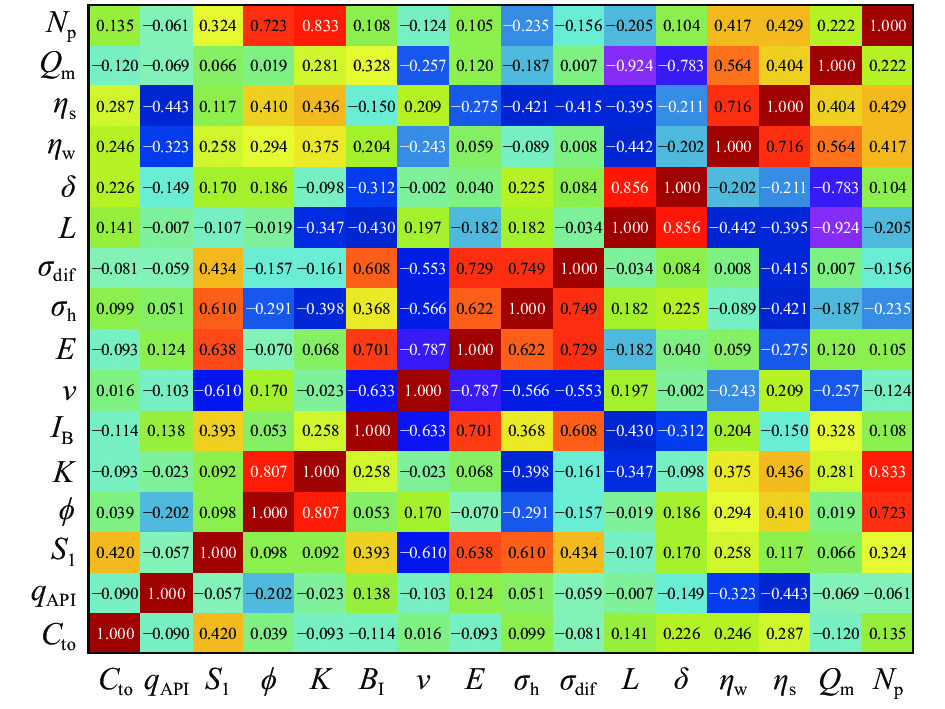
 下载:
下载:
